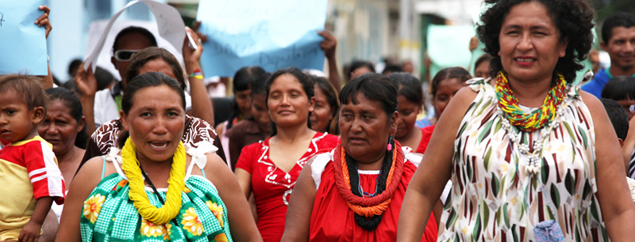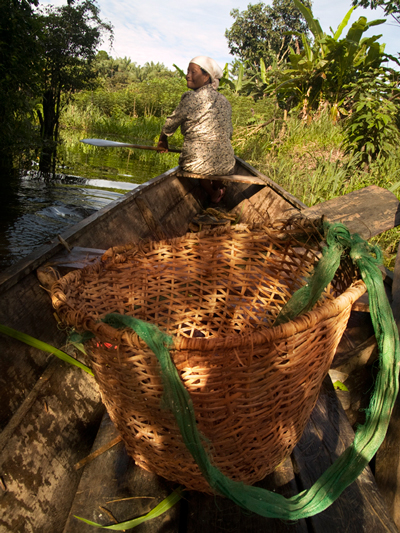
Nature vs. Nurture: How indigenous women of South America are fighting the circumstances that defy their culture
22 April, 2011It is a common belief that women in the western hemisphere enjoy greater rights than their global peers and that their socio-political emancipation has set a precedent. Although it is undeniable that women in Europe and North America have indeed come to be near to equal players in society, the idea that other cultures have yet to catch up is a premise that many indigenous women of South America are challenging.
According to them, gender relations, rather than having improved in a linear, progressive form as has been the case in other cultures, have in fact degenerated in the face of external influences, the latter manipulating the natural organic processes of their communities. Today, indigenous women are seeking to readdress a balance that once existed whilst remaining deeply and necessarily integrated within the wider indigenous movement. Rather than aspiring to western models of organisation that look forward and seek improvement, they are articulating a different root that harks back to how social relations once were.
“We [men and women] have always been side by side, and we still want to be”.
Isabel, leader of Tikuna women’s group OGMITAS, Brazil
Amongst the Tikuna people of the Solimões River in the Amazonas state of Brazil, women traditionally have been as decisive and present in the development of their communities as have been the men. After the fall of the military dictatorship and leading up to the renewal of the Brazilian constitution in 1988, the Tikuna people played an important role in articulating clear demands for the indigenous people, within which territorial demarcation and political participation both featured heavily. Their efforts were triumphant to a great degree, and today a large part of their historically-populated expanse of land is now protected from invasion, deforestation and non-indigenous commercial interests that may interfere with the livelihoods and traditions of the Tikunas. Alongside these advances, they have formed numerous associations and political unions in an attempt to organize and maintain resistance against external political forces that constantly seek to debilitate indigenous unity. Women have been ever-present in these processes, most visibly in the communities of Bom Caminho and Filadelfia, where they have set up successful groups to support the entrepreneurial initiatives of their craftswomen, guaranteeing for the first time financial independence, as well as holding significant leverage in local political deliberations. Their participation is very much in tune with how men and women have always organised themselves, resting on the fundamental idea that both must work, contribute and be responsible for their family, home and survival.
Nonetheless, equal distribution of labour and shared responsibility, traits once immediately evident in many indigenous cultures, have over the years slowly been eroded, resulting in an assumption that these communities are essentially sexist ones. Whilst there exists, to the western frame of mind, clear instances of sexism, for example, the isolation of women during their menstruation or the steep rate of teenage pregnancy resulting in their confinement to the home, their history is a lot more complex than a one-way power relationship between men and women, and one that has been irreversibly influenced by the arrival of non-indigenous forces, such as the catholic church, the premise of a nation-state and capitalism.
In Brazil, Venezuela and other South American countries, there appears to be a distinct pattern in male-female relationships, wherein the dynamic differs between the pre and post-colonisation period, the latter being a phase precipitated and intensified over the last fifty to seventy years. Where and when women suffer greater abuse and discrimination tends to occur in non-indigenous paradigms rather than indigenous ones. The rubber plantations under European control in the area of the Solimões River demanded a male dominated workforce out in the plantations, and created a new pool of female labour whereby the women were employed for the domestic services of the plantation owners. Culturally, this meant that the work of the men was deemed more important and superior to the work of the women, as the man was rewarded with occasional payment and alcohol, whilst the woman was relegated to subservient positions, often with no rewards at all. Because this plantation-based society was one that grew following the world’s demand for rubber during WW2, there is the possibility of comparing realities before and after as many are still alive and can vouch for the change that occurred in male-female relationships.

They relate how the settlement of the new plantations and the arrival of money created a change in the previous division of labour that saw both men and women fishing and cultivating together. Suddenly, because the man could earn a salary, his status within the community inflated and upset a natural balance that had up until then characterized Tikuna relationships. There exists the same argument amongst the Pemón who complain how the mining for gold and diamonds in La Gran Sabana, Venezuela, has changed community relations. The extreme working conditions lived by the miners, together with the often solitary nature of the trade has caused a sharp rise in the consumption of alcohol and rates of prostitution, factors that have had a clear impact on the women of the Pemón communities. Alcoholism and the subsequent domestic abuse that has followed was, as many women note, not a problem before the arrival of mining.
“What’s that part of the Bible that says the woman came out of a man’s ribs? How ridiculous! Have these whites never given birth?”
Dalia Yánez, Warao activist and member of the National Assembly, Venezuela
Before these circumstances, the response on behalf of indigenous women, rather than forming a separatist movement in the face of a growing misogynist and non-indigenous culture, is to return to the platform they once shared equally with their male counterparts. In Venezuela, although most groups have lost many of their traditions, there still exists a sentiment among the women that they are equal players in their communities. The Warao people of the Orinoco Delta, whose traditional culture was one based on unpaid self-sustainable work, wherein tasks were distributed according to the strength and ability of each individual, now find many of their men and women out of work as capitalist society has replaced the original models of indigenous organisation. As a result, women are taking an active part in local politics in the hope of defending not only women but Warao culture in general. So much so, that today, they occupy more positions of influence then Warao men. Andreina Medrano, prominent member of the Warao council from Winikina has endeavoured to encourage and promote the rituals and ceremonies of her community across the Delta state:
“It is fundamental we continue to practice our rites, yet sad that we need to be reminded to do so. It’s because our chants and dances aren’t paid jobs that people have started to concentrate on earning a living rather than maintaining the centuries of heritage behind and upon us. If we forget it, we will lose who we are.”
The Pemón of La Gran Sabana have lost a great part of their culture due to the ever-increasing influence of the Adventist and Evangelical Church. Christian religion has prohibited previous modes of survival, such as hunting and the consumption of certain foods in order to fit foreign moral codes, meaning that instead of living off their land freely and learning from their forefathers´ wisdom, they now buy frozen chicken at the supermarket and turn to the bible for guidance. Reaction to the degeneration of Pemón Culture has been taken up by their women, who within the region are most likely to be cacique, indigenous community leader, than men. One group from the community of Kumarakapai have taken on the task of documenting on tape their oral traditions, interviewing their elders in order “to return to how things were for our grandparents”.
Indigenous feminism then cannot be made separate from the indigenous movement in general. In all cases, women organize themselves to defend their entire communities and recover the values that once held them together. In an age that seeks progression and change, the articulations of the indigenous populations of South America are spying a whole different course, an old one, the one that worked for them.
Determining reasons for the women’s activism beyond the inherent cultural role and duty they may feel, can be a difficult task if generalisations wish to be avoided. Still, many indigenous women feel that they are somewhat responsible. “We are the mothers, we speak and teach our language to our children, we are the carriers of our culture”, a sentiment felt and uttered repeatedly across the continent. Whatever the case, their growing presence in both indigenous and non-indigenous spheres deserves a closer following, and may offer a perspective the whole world could learn from.
All photos by Francesca Commissari
Follow Sounds and Colours: Facebook / Twitter / Instagram / Mixcloud / Soundcloud / Bandcamp
Subscribe to the Sounds and Colours Newsletter for regular updates, news and competitions bringing the best of Latin American culture direct to your Inbox.

